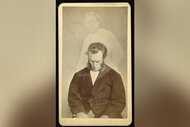Create a free profile to get unlimited access to exclusive videos, breaking news, sweepstakes, and more!
Why The Myth Of Poisoned Halloween Candy Continues To Haunt Trick-Or-Treaters
For years, parents have worried their trick or treaters might be poisoned by an unsuspecting neighbor on Halloween, but is there any validity to the myth?

When kids set out to trick or treat on Halloween, parents often caution that they do one of three things: Look both ways before crossing the street, stick together, and don’t eat anything suspicious.
The latter rule came to fruition amid the fear that a crazed person will lace candy with poison, killing unsuspecting trick-or-treaters. But is there any evidence to suggest this concern should be taken seriously?
Well, not really. As spooky season, as well as Oxygen’s “Homicide For The Holidays” series, returns this October, it’s worth revisiting the origins of this pervading fear, which seemingly began with an op-ed published by The New York Times in 1970.
On Oct. 28, 1970, writer Judy Klemesrud wondered if there was going to be an uptick in poisonings, fomenting fear by suggesting that the “plump red apple” from the “kindly old lady down the block…may have a razor blade hidden inside,” according to CNN. Klemesrud’s concerns were spurred by two unconfirmed reports of children being injured while trick or treating in upstate New York.
Timothy O'Bryan murdered on Halloween
Reader’s concerns grew when 8-year-old Timothy O’Bryan died in Houston, Tex. on Oct. 31, 1974. A medical examiner later determined little Timmy had been poisoned with cyanide, which had been packed into Pixy Stix candy, according to Vice.
Investigators would later discover that Timothy’s father, Ronald Clark O’Bryan, had given Timothy, his 5-year-old daughter, Elizabeth, and more children the poisoned Pixy Stix, which had been resealed with a staple.
“That's what saved another boy's life that night," former Harris County prosecutor told Vice in October 2016. "They found him in bed with the sweet in his hand, but he wasn't strong enough to undo the staples."
O’Bryan, it turns out, had taken out $30,000 life insurance policies on both Timothy and Elizabeth, according to Vice. He was more than $100,000 in debt. Although he pleaded not guilty, he was convicted by a jury on one charge of capital murder and four counts of attempted murder in June 1975. He was executed by lethal injection on March 31, 1984.
Though Timothy’s death is one of the few confirmed cases of poisoned candy being passed around on Halloween, the myth persists.
Is trick-or-treating safe?
“I’ve done research, and I can’t find any evidence that any child has been killed or seriously hurt by any candy picked up in the course of trick-or-treating. My view is this is overblown. You can’t prove a negative, but it seems unlikely,” Joel Best, a professor of sociology and criminal justice at the University of Delaware, told Vox.com in October 2017.
To see some spooky crimes not involving candy or razors, tune in to Homicide For The Holidays on Oxygen. Stream past seasons now here or on Peacock.
Originally published Oct 3, 2022.































